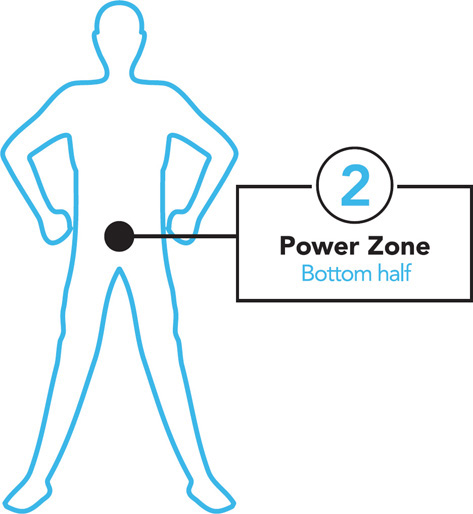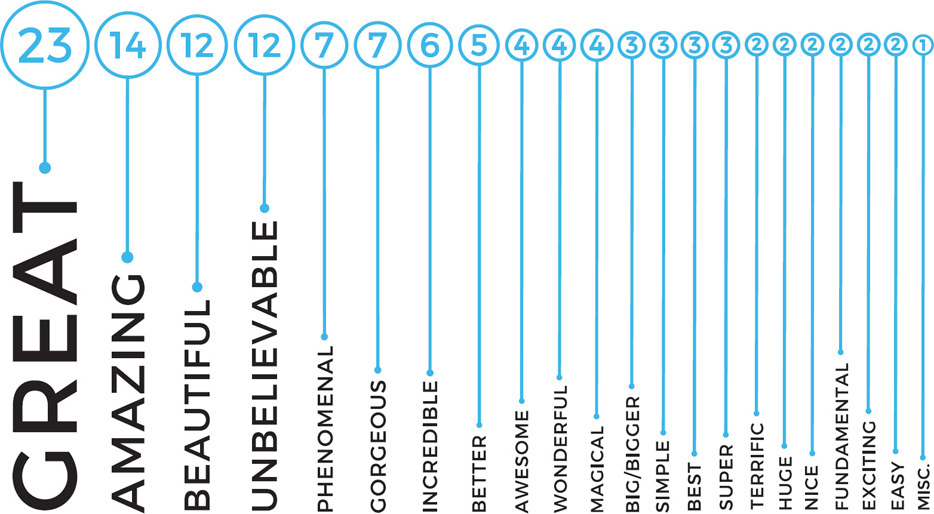
Chapter 20
QUADRANT 2: SHARING
Ideas are transmitted every single day. Upon further examination, most are distributed via facts and stats, while the best are expressed creatively through stories, visuals, and great delivery.
Research shows that a compelling story makes all the difference with audiences: 63 percent of presentation attendees remember stories, while only 5 percent remember statistics.1 When a story is delivered by a dynamic speaker, you are in for a treat. It’s what the Sharing quadrant is all about.
WHY SHARING MATTERS FOR PRESENTERS
Your Badge score in Sharing illustrates how you perform and deliver your message (oratory and visual) onstage. Are you charismatic, confident, conversational, comfortable with your hands and feet, and dressed appropriately for the venue? Do your slides look gorgeous, or were they built using the latest PowerPoint template? It’s everything that comes to mind when you think about the very act of delivering a talk. It’s your voice, your nonverbal behavior, and everything else you do onstage.
EXAMINING A PROFESSIONAL FROM THE PAST
In the 1950s, the world was introduced to a trailblazing businesswoman who was decades ahead of her time. She took a struggling product and made it into a huge success by utilizing her charismatic public speaking skills in a “party plan” system she created. Her name was Brownie Wise, and the product was Tupperware, which sold over $2 million worth of products2 in one calendar year. In a short period of time she created a plastic food-storage empire that was adored by households across America for many years.
Brownie Wise did not inherit success. She worked for it. In the 1940s, she found herself divorced single mom. At that time, a Stanley Home Products dealer came to her door, and according to Bob Keating,3 author of Tupperware Unsealed, this person fumbled the presentation. Wise thought, “I could do better than that.” The rest is history. Wise soon took a position with Stanley, and eventually she made her way to working with Earl Tupper of Tupperware.
How did Wise take a failing product and make it a household name? It was her ability to present and sell. She had the gift of being able to woo anyone she came in contact with because of her magnetic personality, depth of knowledge, and passion for what she was selling. Wise understood the importance of the Sharing quadrant. She was electric and a great storyteller, and she made every home party appear effortless and easy. Her ability to lead, inspire, and rally ushered women into the workforce to make their own money and help provide for their families. She is a heroine with Durability.
LEARNING FROM A PROFESSIONAL TODAY
In February 2012 in Long Beach, California, writer and lecturer Susan Cain delivered an amazing TED Talk, “The Power of Introverts,”4 which was based on the brilliant research she did for her book Quiet.
There were many components that made her research and her talk brilliant, but the special item worth noting for this discussion was her use of a particular prop: a briefcase. She held this briefcase the entire first minute of her 18-minute talk as she painted a picture of her self going off to summer camp at the age of nine with more of a desire to read books than to make new friends. You can’t help but relate to her story as you are flooded with your own memories of going to camp or traveling.
Throughout her talk, she used this prop to tell a beautiful story with precision and well-rehearsed punch lines. It was clear that every word she shared was carefully chosen and every action was rehearsed and planned. The end result? Her audience fell in love with her story and her research. Cain mastered the Exploration quadrant in order to shine in the Sharing quadrant. She told a beautiful story, she made her content relatable by incorporating a prop, and she used gestures and nonverbal behavior to enhance audience interaction and feedback.
MASTERING THE SHARING QUADRANT
If you are an entrepreneur or just passionate about business in general, then the name Gary Vaynerchuk is probably familiar. You may have read one of his books, or perhaps you subscribe to his YouTube channel. The guy loves video, and he is brilliant at connecting with his audience 24/7. He’s completely magnetic and passionate, and it comes through every time he takes the stage or records a video.
Gary Vaynerchuk rose to popularity via his Wine Library TV show, and he really struck it big with his exuberant 2008 Web 2.0 Expo keynote,5 where he said the following:
If you love ALF, do an ALF blog. If you collect Smurfs,
Smurf it up. Whatever you need to do, do it!
But Vaynerchuk struck a chord about three and a half minutes into his talk when he knelt down onstage and pleaded with his audience to stop complaining and step up. This small move made him relatable and tore down any potential walls between him and the audience.
Vaynerchuk shocked the world with his unique speaking style, brutal honesty, and authentic approach. For his presentation at HubSpot’s 2012 INBOUND conference, he dropped a whopping 76 f-bombs in 45 minutes and used only one PowerPoint slide. That’s unheard of in today’s business climate, but it didn’t matter. Why? He knows how to work the stage and speak from the heart. He did it so well that it earned him a standing ovation that morning. Vaynerchuk doesn’t rely on technology or fancy gimmicks. He just wants to share what’s in his heart and on his mind.
A sharing heart is at the core of all great presenters. They care about adding value. They care about giving back. They care about making mental and emotional deposits that will make a radical difference in the lives of their audience. In other words, great presenters know how to maximize their moment on stage because they are masters at sharing their message.
BEING PROACTIVE RATHER THAN REACTIVE
Let’s face it. We live in a world full of judges. For every presentation you give between now and the day you retire, you are going to be judged by every single person. What we want to do now is provide you with some tips and tricks to minimize the level of judgment you will face.
DRESS THE PART
We have two rules of thumb:
1. DRESS ACCORDING TO YOUR OBJECTIVE.
If you want to raise $2.7 million for your startup, then dress the way some- one would dress if he or she were asking for $2.7 million.
2. DRESS ACCORDING TO YOUR BRAND.
If you work for a stuffy and stodgy corporate brand, then dress in stuffy and stodgy clothes. If you work at a hip and cool agency, then dress in hip and cool clothes. That also applies to your personal platform. If you are known as being innovative and cutting edge, then dress in innovative and cutting-edge clothes.
When in doubt, overdress for your presentation, and treat it with the same level of seriousness you would a job interview. If you play the conservative card, then we suggest being mindful of the following items:
Shoes. Black or brown shoes are your best bet. They are safe and traditional, and they don’t raise any eyebrows.
Ties. If you opt for a tie, go with solid colors and nothing too bright or abstract.
Jewelry and Makeup. Sometimes makeup or a certain piece of jewelry can be a distraction. Tone it down. You can’t go wrong with a string of pearls or a simple gold chain. When in doubt about a piece, don’t wear it.
HAVE A BACKUP PLAN
We’re going to borrow from our friend Guy Kawasaki on this one. In his book The Art of the Start, he says that everything that goes wrong during your presentation is your fault. It’s true. If the projector dies, it is your fault. If your laptop dies, it is your fault. If the batteries in your remote die, it is your fault. Everything with your presentation is your responsibility, so you need to plan and prepare accordingly.
Start by showing up on time. If you are invited to speak at a location you have never been to before, arrive 45 to 60 minutes early to scope out the room and check the setup. Will you be presenting via a 16:9 format? 4:3? Whiteboard? You must be prepared. Upon your arrival, make sure that you have two to three backup plans. Is your presentation also saved in Dropbox? Do you have it on a flash drive? Do you have a copy of it ready to go on your iPhone or Android device? We live in the era of the cloud and mobile devices, so excuses or technological errors are unacceptable.
Remember, Murphy’s law is real: “Anything that can go wrong, will go wrong.” We mention it only because we see it happen all the time. A lack of a backup plan will find a way to reveal itself in the ugliest situations. Don’t be the next victim.
PERFECT THE REFLECTION
When you present, everything you do and everything you share is a reflection on you. It always amazes us when we see someone who has obviously spent hours creating and designing a beautiful presentation slide deck only to give us a plain-looking handout in Microsoft Word. It’s an instant credibility killer, and it is a poor reflection on the presenter. Aim for consistent quality among all the assets you will share and deliver.
If you treated your Exploration quadrant seriously, then we hope you have a beautiful-looking slide deck. Just remember that if it looks cheap, you look cheap. If it looks amateurish, you look amateurish. Everything you say and display is a direct reflection on you.
ACHIEVING AUTHENTICITY
One of your main goals as a presenter is to be authentic. Simply, you need to be yourself when you are in front of a roomful of people or at center stage. We have all had our fair share of experiences as audience members, and we know how easy it is to spot a poser or faker. Embrace some of the following rules.
GET HONEST FEEDBACK
The best place to understand how others perceive you and your level of authenticity is to start with something like a 360 review. And here is the really exciting news: you can use Badge to do peer reviews of your presentation style just like a traditional 360 review. Simply have your colleagues take the assessment on your behalf. The traditional 360 review is a practice we take very seriously at Ethos3, where we give every team member an opportunity to assess his or her peers and colleagues by submitting a review of them. We’ll evaluate everything from leadership skills to job knowledge to how they live our core values. This same level of seriousness can also be applied to the Badge assessment, which makes it an excellent 360 tool.
SELF-DISCLOSE INTELLIGENTLY
According to a Harvard Business Review article,6 stories are great at building on your relationships with others. They are not great at starting those relationships. I (Scott) will give you a recent example from my own life. My wife and I were invited to dinner by some friends we had just met. Over the course of the evening, the conversation shifted toward hobbies and exercise. One person divulged his love of weight lifting and his hatred of cardio, specifically running. He then asked, “What sport do you participate in?” I shyly answered, “Well, I’m a triathlete. I love to swim, bike, and run.” Obviously, this was not a big deal to me or him, but it is a great example of how an individual can reveal too much too soon. Be careful not to share too much until you learn more about your audience.
You have to pick and choose your moments to be vulnerable. Sharing information about yourself can help break down barriers, but when you share too much, it can quickly turn from helpful to awkward.
DON’T BE AFRAID
At the end of the day, you cannot be afraid to be yourself, warts and all. You were asked to speak at this engagement for a reason. The meeting organizer, prospect, or client obviously found you or your brand intriguing, so don’t deviate from that foundation.
PRESENTING WITH PASSION
You can spend the rest of your career trying to master all the quadrants, but here is a simple reality: if you are not passionate about your message, no one else will be. We love these quotes:
The most powerful weapon on Earth is the human soul on fire.
—Ferdinand Foch
Light yourself on fire. You’ll be amazed at the number of people who line up to watch you burn.
—Rob Roy, The Navy SEAL Art of War
Passion is everything.
EMBRACE YOUR POWER ZONES
Harvard professor and researcher Amy Cuddy delivered the beautiful TED talk “Your Body Language Shapes Who You Are,”7 in which she revealed how just two minutes of holding a power pose can increase levels of testosterone and lower levels of cortisol (the stress hormone).8 While Dr. Cuddy’s work has been challenged, we thought it worth sharing here.
MANAGE YOUR TOP HALF
To control and maximize this part of your body, you need to keep your head and chin up (Figure 20.1a). You may also complement this effort by putting your arms up in a V shape, which will give you the feeling of power and authority.

Figure 20.1a Power Zone: Your Top Half
Source: http://blog.ted.com/fake-it-til-you-become-it-amy-cuddys-power-poses-visualized/.
MANAGE YOUR BOTTOM HALF
Think about your feet and everything below your waist (Figure 20.1b). Do a Superman or Wonder Woman pose with your hands on your hips, legs apart, and chest out. It showcases control and power. When confronted by another—perhaps your boss is yelling at you—keep your legs apart, and it will display that you are not a pushover.

Figure 20.1b Power Zone: Your Bottom Half
Source: http://blog.ted.com/fake-it-til-you-become-it-amy-cuddys-power-poses-visualized/.
SPEAK WITH AUTHORITY
There are two speaking styles plaguing our business culture right now. The first is uptalk and the second is vocal fry. You need to avoid both.
Uptalk. Uptalk is the act of taking a statement and turning it into a question by using an upward inflection. It’s so prevalent that some experts are beginning to call it an epidemic. If we stop and analyze a fictional conversation with a customer service representative, it may look like this example:
Customer service associate: Whom am I speaking with?
David: My name is David?
Customer service associate: Date of birth?
David: 4/19/84?
Even though David intended to sound confident, it can be easy for him—or anyone, for that matter—to get thrown off by a question and then answer it with a question rather than a confident statement. This behavior is often referred to as Valley Girl-speak; the presenter or speaker is perceived to be an airhead or ditz. This seriously undermines credibility.
Vocal Fry. Vocal fry is an equally troubling epidemic. It happens when an individual uses his or her lowest vocal register. Our vocal chords are composed of four registers.9 The lowest is fry, followed by modal, falsetto, and whistle. Most people speak in the modal range. However, according to several recent studies,10 many people are using vocal fry more often these days. In fact, two-thirds of women are using vocal fry on a regular basis. The more vocal fry, the less authority we project, so as presenters we need to take note.
How do you fix these issues?
1. LISTENING.
Listen to yourself and others, and focus on becoming more self-aware and mindful moving forward. Stop uptalk and vocal fry before they start.
2. BREATHING.
Make sure you connect your voice to your breath. Focus on letting your breath come from your belly when you speak.
BE A WORDSMITH
If you watch any Apple presentation, executives use a few select key words. You’ll constantly hear words such as “great,” “amazing,” “wonderful,” and “incredible.” This is no accident; it is highly intentional. If we revisit the iPad launch presentation from 2010,11 Figure 20.2 shows what Steve Jobs and his executive team’s word count looked like.

Figure 20.2 Steve Jobs and his executive team’s Word Count in the 2010 iPad Launch Presentation
When you think of iPhones, Apple wants you to think “great” or “amazing.” When you think Apple Watches, the company wants you to think “incredible.” As presenters, we need to do the same thing. Pick a few key words, and make sure to drop them strategically throughout your next talk.
CONCLUSION
Mastering the Sharing quadrant is no easy feat. It takes confidence, charisma, and lots of preparation. It’s hard to be magnetic onstage, but it is not impossible. Anyone can do it if he or she is willing to put in the time and effort. Be intentional with every word and action.


 REMEMBER
REMEMBER